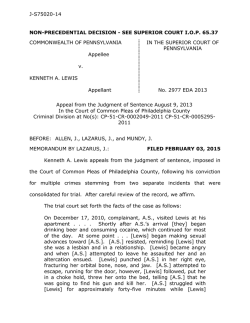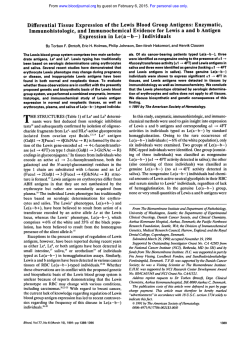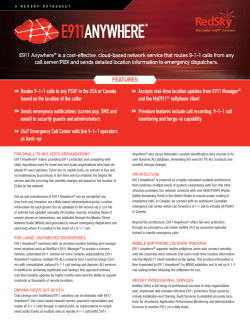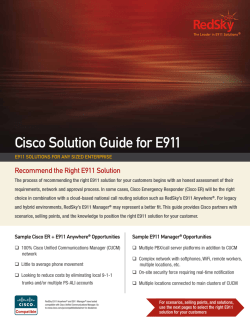
Final 2012-2015 Plan.pub
With an Eye on the Future Lewis County 2012-2015 STRATEGIC PLAN 2012-2015 Strategic Plan To Elected Officials, Department Directors and Citizens of Lewis County The last six months spent updating the Lewis County Strategic Plan has resulted in this report. We have taken our time to provide for as much input and discussion as possible. The six month process is outlined below: January Executive Steering Committee (ESC) discussed the need to update our current Strategic Plan February Goals, programs and projects were submitted and combined into draft form March Team leaders were selected and teams formed April-May Team leaders held meetings, conducted interviews and analyzed their priorities June A Strategic Planning Workshop was held to narrow the goals July Adoption of the 2012-2015 Strategic Plan This extensive process allowed for a broad range of input. Strategic Teams wrote reports that included ideas from elected officials, management, line staff and members of our community who are experts in their field. During the process the focus has been what needs to be done and how will we fund these needs over the next three years. Our current economic situation has severely limited our capacity to maintain, much less expand, services to our citizens but serving our citizens is always our first priority. There are projects or programs included in this plan that do not have funding at this time. These are the top priorities of Lewis County government and we will be researching ways to fund these projects. We would like to thank all who participated in the development of this plan as it is invaluable in setting policy and prioritizing financial decisions over the next three years. Board of County Commissioners F. Lee Grose Ron Averill Bill Schulte 2 STRATEGIC TEAMS The following team leaders, in conjunction with team members developed the reports that have been incorporated into this 2012-2015 Strategic Plan. The Board of County Commissioners would especially like to thank the team leaders for their support of this project. Law and Justice Team Leader: Judge Mike Roewe with consultation from Superior Court Presiding Judge Richard Brosey, Juvenile Court Administrator Holli Spanski, County Clerk Kathy Brack, District Court Judge R.W. Buzzard, and Prosecuting Attorney Jonathan Meyer Public Safety Team Leader: Sheriff Steve Mansfield with consultation from Jail Administrator Kevin Hanson, Chief Civil Deputy Stacy Brown and Sergeant Ross McDowell Public Services Team Leader: County Treasurer Rose Bowman with consultation from Health and Social Services Director Danette York, County Clerk Kathy Brack, Central Services Director Michael Strozyk and Community Development Office Manager Donna Olson Public Health Team Leader: Public Health and Social Services Director, Danette York with consultation from Health Officer Rachel Wood; Tara Smith; John Abplanalp; Deborah Shawver, Providence System.; Amber Lewis, Providence Health Services; Brett Mitchell, Reliable Enterprises; Jenni Bodnar, Health Partnership/Thorbecks/Lewis County Community Trails; Steve Clark, Valley View Health Center. Capital Facilities Team Leader: Central Services Director Michael Strozyk with consultation from the Capital Facilities group members which includes Commissioner Lee Grose, Treasurer Rose Bowman, Chief Accountant Larry Grove, IT Manager Steve Wohld, Facilities Manager Doug Carey and Budget Director Dawna Truman Economic Development Team Leader: Community Development Director Bob Johnson with consultation from Public Works Director Tim Elsea and Dick Larman-Economic Development Council Government Services Team Leader: Information Technology Manager Steve Wohld with consultation from Treasurer Rose Bowman, Assessor Dianne Dorey, Chief Accountant Larry Grove, Budget Director Dawna Truman, Human Resources Administrator Archie Smith, Human Resource Generalist Eileen Sherlock, Solid Waste Manager Steve Skinner, IT Specialists Dirk Haney, Matt Trent, and Gabe Anzelini, Lead Permit Tech Cheryl McGee, Real Estate Manager Larry Unzelman, and Office Assistant Linda Ray 3 PUBLIC SAFETY STATEMENT: The protection and prevention of the citizens from danger, injury, damage or harm as may occur during a man-made or natural disaster or a criminal act. GOAL #1: Develop a High Utilizer Identification Program OBJECTIVE: Develop, implement and maintain a “High Utilizer” identification, classification and action program that reduces recidivism within the Criminal Justice System. Strategy #1: Work with mental health and chemical dependency service providers to define high utilizers. Strategy #2: Create data mining resources to provide statistical data. Strategy #3: Coordinate services with local mental health professionals to provide transition services to inmates in need of mental health and chemical dependency care. Strategy #4: Participate in community safety meetings to provide input to participants to ensure after incarceration services. Timeline: 12 months - July 1st 2013 Estimated Cost: Included in current operational budget. No increased cost to the county. GOAL #2: Develop and implement Lewis County Government Emergency Action Plan OBJECTIVE: Ensure Lewis County Government has the capability to work cooperatively to mitigate, plan, respond and recover from emergency and disaster situations. Strategy #1: Develop and write the EAP. The document will identify who will do what, with what, and in what order. It also identifies gaps for mutual aid agreements and future mitigation projects. Strategy #2: Issue an administrative directive from the Board of County Commissioners for the preparedness, training and exercising of a county emergency action plan. Strategy #3: Provide for implementation, training and maintenance of the Emergency Action Plan. Formally implementing the EAP, conducting countywide orientation/training and assigning the plan maintenance function is critical for ensuring that everyone understands their roles and responsibilities for response and recovery from emergency or disasters. 4 PUBLIC SAFETY Strategy #4: Develop, train and maintain building safety plans to protect visitors and the employees working in the Lewis County public buildings from the effects of emergencies or criminal acts. Timeline: 24 months - July 2014 Estimated Cost: Hours spent are included in current operational budget. Additional costs: Training $2,500 Materials $2,500 GOAL #3: Plan, prepare, and practice for response to public health emergencies. OBJECTIVE: Most emergencies have the potential to impact citizen’s health. In order to protect county residents we must plan for and maintain capacity to respond to natural and man-made disasters. Strategy #1: Develop and/or update appropriate emergency response plans. Strategy #2: Collaborate with partner agencies to train and exercise jointly. Strategy #3: Develop alternate care facility plans with the help of the medical community and law enforcement. Timeline: Development and updating plans occurs annually – at least one exercise should be performed annually Estimated Cost: The county currently spends ~$48,000 annually. No additional cost to county and approximately $1,500 per year for partners. 5 PUBLIC SERVICES STATEMENT: To research, develop and fund projects and programs that will improve public access to the services of county government. GOAL: Improve access of county services to citizens OBJECTIVE #1: Improve external website. Strategy: Add a search engine to the county’s website that will allow users to search the site for the information needed. This will also allow citizens to locate where services are delivered and directions to find that location. Timeline: Completion by January 1, 2013 Estimated Cost: ~ $5,000 or less depending on features OBJECTIVE #2: Improve the public’s ability to locate where services are delivered after they are already on campus. Strategy: Install a Smart Kiosk in the first floor corridor of the historic courthouse so that the public can query for services location. Timeline: Completion by June 2013 with full access Estimated Cost: ~$7,500 or less OBJECTIVE #3: Expand the ability to utilize electronic payment for government services Strategy: Survey the county offices and department as to current practice and where needs lie. Identify barriers – such as statutory- and work on solutions. Timeline: January 1, 2013 for survey – timeline for solutions is tough; if it is a statutory issue it will take longer. Estimated Cost: ~$10,000 depending on scope of project yet to be determined. OBJECTIVE #4: Improve public access to all buildings on campus by improving crosswalk safety. Strategy: Research grants and funding for viable solutions such as: flashing lights at crosswalks that have high utilization levels or flags for the pedestrians to use to signal traffic. Estimated Cost: Depending on options selected, approximately $2,500 6 PUBLIC HEALTH STATEMENT: To improve the health status of Lewis County and decrease healthcare costs GOAL: Increase effectiveness of social, medical, behavioral and preventive health services available in the County OBJECTIVE #1: Complete a single county-wide health and social needs assessment Strategy: Partner with private and public, profit and non-profit County agencies to perform the needs assessment Timeline: Completion by June 30, 2014 Estimated Cost: ~$55,000 depending on scope of project; some costs will have offsetting grant revenue. OBJECTIVE #2: Use findings from the needs assessment to identify and address gaps Strategy: Prioritize gaps to be addressed. For example: Social Health – increase graduation rates, decrease teen pregnancy rates, and decrease number of persons who are homeless Medical Health – decrease rates of diabetes, heart disease, lung disease, and cancer Behavioral Health – increase number of persons who have the ability to access affordable mental health and chemical dependency treatment services Preventive Health – increase child and adult immunization rates Timeline: Completion by December 31, 2015 Estimated Cost: ~$490,000 depending on scope of projects; some costs will have offsetting grant and tax revenue 7 LAW AND JUSTICE STATEMENT: To enhance access to and the effective delivery of conflict resolution between citizens, and between citizens and government. GOAL #1: Creation of Youth Traffic Court OBJECTIVE: Chapter 3 of the Revised Code of Washington authorizes the District Court, in coordination with local school districts, to create a youth court to which alleged traffic infractions by those less than 18 years of age can be referred. Students, under the supervision of the court, serve in various capacities within the youth court acting as judges, jurors, lawyers and clerks. It provides a method to educate youth about the court system and encourages involvement as adults. Strategy #1: Initiate contact with local superintendents of schools and high school principals to determine interest. Strategy #2: Initiate a pilot program with one school to determine and demonstrate student interest. Strategy #3: With assistance of Office of Administrator of the Courts develop details of the program. Timeline: Program design by October 2012. Contact with schools by February 2013. Pilot project to be operational in September 2013. Estimated Cost: $5,000 8 ECONOMIC DEVELOPMENT STATEMENT: For our citizens to prosper the county must prepare for economic development opportunities by developing and implementing plans related to land use, infrastructure development, and financial resources. GOAL: Prepare for economic development opportunities OBJECTIVE #1: Zone for development. Strategy #1: Identify areas where growth is desired and implement land use zoning to allow development to occur at those locations. Strategy #2: Work with stakeholders and the public to identify the types of businesses and development desired and the area most appropriate for such economic development. Adopt zoning designations to support economic development opportunities. Timeline: To be completed by the end of 2013. Estimated Cost: $50,000 OBJECTIVE #2: Adopt development-friendly land use regulations that allows development to occur in a timely and predictable manner. Strategy: Work with stakeholders and the public to make sure development regulations support and encourage economic development opportunities. Timeline: To be completed by the end of 2013. Estimated Cost: $50,000 OBJECTIVE #3: Develop infrastructure plans to support economic development. Strategy: As appropriate, perform studies and analyses, develop infrastructure plans, including water and sewer, financial plans and rate structures necessary to support infrastructure needs. Timeline: To be completed by the end of 2014. Estimated Cost: $350,000 9 ECONOMIC DEVELOPMENT OBJECTIVE #4: Build infrastructure necessary to support anticipated development. Strategy #1: Construct infrastructure necessary to support anticipated development to position the County for opportunities for new economic development. Strategy #2: Implement plans; identify financing and construct infrastructure. Timeline: Dependent on funding sources Estimated Cost: $40,000,000 OBJECTIVE #5: Market Lewis County for new economic development opportunities. Strategy: Create a marketing plan to give wide exposure to the advantages of developing in Lewis County. Strategy: Work with stakeholders including the Economic Development Council and Chambers of Commerce to develop and implement a marketing strategy, showing that Lewis County is a great place to do business. Timeline: To be completed by the end of 2014. Estimated Cost: $200,000 10 CAPITAL FACILITIES STATEMENT: Capital facilities must be maintained or improved to provide for public services. GOAL #1: Improve citizen access to county services OBJECTIVE #1: Build a Campus Plaza Building to centralize government operations. Consolidation of county services would assist citizens in making it a “one stop” experience. Currently services are in multiple locations. Strategy: Develop a funding strategy that would enable the county to build a new centralized campus. Timeline: Some design work has been completed and construction will depend on finding a way to fund the project. Estimated Cost: $25 to $30 million dollars depending on final design and property. OBJECTIVE #2: Create additional parking to improve the staff and citizens ability to quickly and efficiently access County services. Strategy: Develop a long term parking solution in conjunction with the centralized Campus Plaza Building and existing Law and Justice Center. Timeline: Design work could start as early as 2013. Construction will depend on funding Estimated Cost: $3 to $5 million depending on size, type and location. GOAL #2: Improve Public Safety Facilities OBJECTIVE #1: Review the current and future needs of the Juvenile Detention Center and make sure those needs and requirements are being met now and into the future. Strategy: Schedule meetings involving necessary parties to reach agreement on a final plan. Provide for funding, draft contracts, and plan temporary relocation of detention and court facilities. Timeline: Final design decision by 12/01/12. Commence construction as funding allows. Estimated Cost: $7 to $15 million depending on size, property and construction 11 CAPITAL FACILITIES OBJECTIVE #2: Combine E911 Communications Center and Emergency Operations Center. Moving the center to a more secure location and combining the county emergency operations center would enable Lewis County to more effectively and efficiently provide services to our citizens, especially during disasters. Strategy: Research and develop options for constructing a combined facility to house the Countywide E911 Communications Center. Research the possibility of combining with a secure data storage center. (See Internal Operations Goal #2 Objective #5) Timeline: Design to begin mid- 2013 Estimated Costs: $3 to $5 million depending on location and size. 12 INTERNAL OPERATIONS STATEMENT: Technological improvements and work processes are always changing and affect how we do business. It is imperative that our internal and external services are always being updated to ensure that they remain efficient and effective. GOAL: Improve efficiency and effectiveness of governmental operations. OBJECTIVE #1: Encourage long term sustainable funding by writing and adopting financial policies Strategy: Write financial policies to be adopted by the Board of County Commissioners Timeline: By the end of 2013 Estimated Cost: Staff time is included in current operating budget. There will be no additional cost to the county. ~$3,000 OBJECTIVE #2: Review current processes and find ways to improve efficiency through technology improvements. Strategy: Projects to review include streamlining the permitting process, developing campus-wide Wi-Fi, and improving search capabilities on the county internet site. Timeline: 2012 through 2015 Estimated Cost: $20,000 to $30,000 and would also create some ongoing costs OBJECTIVE #3: Improve county training program for employees. Statement: Improve the training process by allowing for more accessible and less costly training processes Strategies: Provide intranet training classes to reduce the time staff spends attending necessary training. Timeline: By 2014 Estimated Cost: Staff time is included in current operating budget. ~$25,000 for software 13 INTERNAL OPERATIONS OBJECTIVE #4: Complete conversion of financial software system. Strategy: Continue to work with developers and implementation team to complete implementation of an updated financial system to meet present and future needs. Timeline: 2012-2015 Estimated Cost: unknown at this time OBJECTIVE #5: Consolidate multiple data storage locations. Strategy #1: Make the current data center more earthquake proof and fire protected. Strategy #2: Install a flood-proof backup generator solution. Our current backup generator for Technology Services, including service to our E911 Dispatch center, is located in the Historic Courthouse and is susceptible to flooding. Strategy #3: Create a data center to allow for off-site storage and effective data recovery if new E911 facility were constructed. Timeline: 2012-2015 Estimated Cost: Projects would range from $50,000 to $250,000 OBJECTIVE #6: Transfer current paper files to electronic format. Statement: The County is suffering from enormous problems involving the storage of and retrieval of paper records. A projected benefit of moving toward a “paperless” county would be a reduction in the cost of thousands of copies currently made each year. Strategy: With the assistance of the county technology department, development of a phased process to acquire staff and equipment necessary to reduce stored paper files to an electronic format. Timeline: Planning completed within 6 months, implementation in 2013, upon approval of funds for equipment and staff. Estimated Cost: $10,000 to $20,000 for hardware 14
© Copyright 2024





